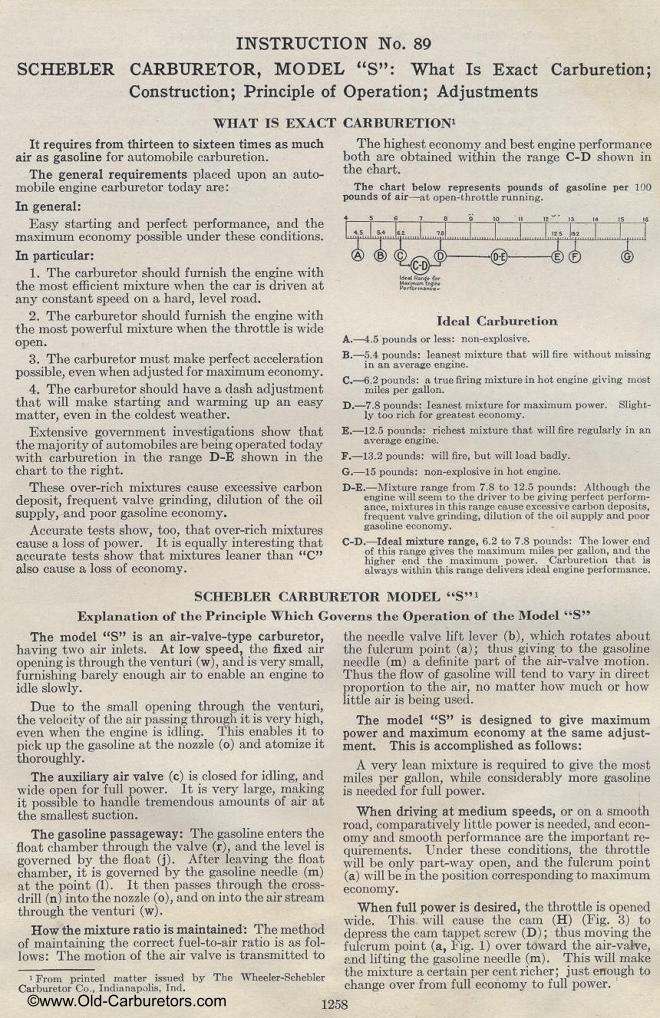SCHEBLER CARBURETOR, MODEL "S"
What Is Exact Carburetion;
Construction; Principle of Operation; Adjustments
WHAT IS EXACT CARBURETION?
It requires from thirteen to sixteen times as much air as gasoline
for automobile carburetion.
The general requirements placed upon an automobile engine carburetor
today are:
In general:
Easy starting and perfect performance, and the maximum economy
possible under these conditions.
In particular:
1. The carburetor should furnish the engine with the most efficient
mixture when the car is driven at any constant speed on a hard,
level road.
2. The carburetor should furnish the engine with the most powerful
mixture when the throttle is wide open.
3. The carburetor must make perfect acceleration possible, even
when adjusted for maximum economy.
4. The carburetor should have a dash adjustment that will make
starting and warming up an easy matter, even in the coldest weather.
Extensive government investigations show that the majority of automobiles
are being operated today with carburetion in the range D-E shown
in the chart to the right.
These over-rich mixtures cause excessive carbon deposit, frequent
valve grinding, dilution of the oil supply, and poor gasoline economy.
Accurate tests show, too, that over-rich mixtures cause a loss
of power. It is equally interesting that accurate tests show that
mixtures leaner than "C" also cause a loss of economy.
The highest economy and best engine performance both are obtained
within the range C-D shown in the chart.
The chart below represents pounds of gasoline per 100 pounds of
air —at open-throttle running.
Ideal Carburetion
A.—4.5 pounds or less: non-explosive.
B.—5.4 pounds: leanest mixture that will fire without missing
in an average engine.
C.—6.2 pounds: a true firing mixture in hot engine giving
most miles per gallon.
D.—7.8 pounds: leanest mixture for maximum power. Slightly
too rich for greatest economy.
E.—12.5 pounds: richest mixture that will fire regularly
in an average engine.
F.—13.2 pounds: will fire, but will load badly. G.—15
pounds: non-explosive in hot engine.
D-E.— Mixture range from 7.8 to 12.5 pounds: Although the
engine will seem to the driver to be giving perfect performance,
mixtures in this range cause excessive carbon deposits, frequent
valve grinding, dilution of the oil supply and poor gasoline economy.
C-D.— Ideal mixture range, 6.2 to 7.8 pounds: The lower end
of this range gives the maximum miles per gallon, and the higher
end the maximum power. Carburetion that is always within this range
delivers ideal engine performance.
IC.,1 aan9. ro,
SCIIEBLER CARBURETOR MODEL "S"
Explanation of the Principle Which Governs the Operation of the
Model "S"
The model "S" is an air-valve-type carburetor, having
two air inlets. At low speed, the fixed air opening is through
the venturi (w), and is very small, furnishing barely enough air
to enable an engine to idle slowly.
Due to the small opening through the venturi, the velocity of the
air passing through it is very high, even when the engine is idling.
This enables it to pick up the gasoline at the nozzle (o) and atomize
it thoroughly.
The auxiliary air valve (c) is closed for idling, and wide open
for full power. It is very large, making it possible to handle
tremendous amounts of air at the smallest suction.
The gasoline passageway: The gasoline enters the float chamber
through the valve (r), and the level is governed by the float (j).
After leaving the float chamber, it is governed by the gasoline
needle (m) at the point (1). It then passes through the cross-drill
(n) into the nozzle (o), and on into the air stream through the
venturi (w).
How the mixture ratio is maintained: The method of maintaining
the correct fuel-to-air ratio is as follows: The motion of the
air valve is transmitted to
1 From printed matter issued by The Wheeler - Schebler Carburetor
Co., Indianapolis, Ind.the needle valve lift lever (b), which rotates
about the fulcrum point (a); thus giving to the gasoline needle
(m) a definite part of the air-valve motion. Thus the flow of gasoline
will tend to vary in direct proportion to the air, no matter how
much or how little air is being used.
The model "S" is designed to give maximum power and maximum
economy at the same adjustment. This is accomplished as follows:
A very lean mixture is required to give the most miles per gallon,
while considerably more gasoline is needed for full power.
When driving at medium speeds, or on a smooth road, comparatively
little power is needed, and economy and smooth performance are
the important requirements. Under these conditions, the throttle
will be only part-way open, and the fulcrum point (a) will be in
the position corresponding to maximum economy.
When full power is desired, the throttle is opened wide. This will
cause the cam (H) (Fig. 3) to depress the cam tappet screw (D);
thus moving the fulcrum point (a, Fig. 1) over toward the air-valve,
and lifting the gasoline needle (m). This will make the mixture
a certain per cent richer; just enough to change over from full
economy to full power.
Previous page 1927
Supplement Home Next page 
|